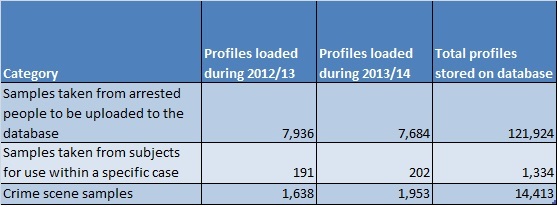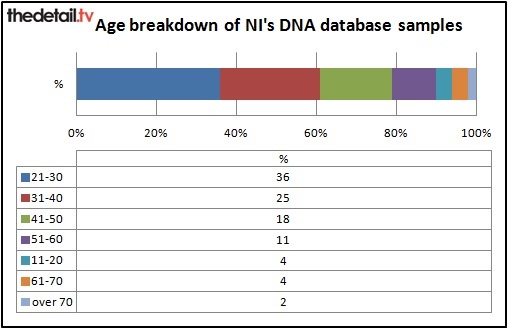THE genetic profile of over 123,000 people is stored on the Police Service of Northern Ireland’s DNA database, The Detail can reveal.
The latest statistics show that new samples from more than 16,000 individuals were loaded from April 2012 to March 2014, bringing the total in the system to 123,258. This includes DNA taken from people arrested by the police, as well as samples taken for use within specific criminal cases.
DNA now plays an important role in solving crimes and securing convictions.
There were 1,180 ‘scene to person’ matches and 49 ‘scene to scene’ matches identified against crime scene profiles loaded to the Northern Ireland database during the same two year period.
Profiles from here exported to the national UK-wide database from 2012 to 2014 were also linked to 161 unsolved crimes in England and Wales – these included murder, manslaughter, rape, burglary, criminal damage and drug related crime.
But there are civil liberty issues around the retention of DNA information and the Northern Ireland Human Rights Commission is among those to have raised concerns about the number of samples being stored.
Chief Commissioner Les Allamby told The Detail: “It is important that any policies surrounding retention of DNA are both compliant with human rights legislation as well as workable for the criminal justice system."
Justice Minister David Ford, however, underlined the value of the database, saying: “DNA profiling is an important investigative tool in identifying people and solving crimes."
The new figures we are reporting on today are contained in a report compiled by the Northern Ireland DNA database governance board.
The publication includes details on the gathering of samples, the role of DNA in solving crimes, while also providing a gender and age breakdown of the Northern Ireland profiles.
The governance board was established in November 2011 to provide assurance to the Minister of Justice on the use and retention of DNA samples and to ensure compliance with legislation.
It includes representatives from Forensic Science Northern Ireland (FSNI), the PSNI, the Northern Ireland Policing Board, the University of Ulster, Queen’s University Belfast, the Information Commissioner’s Office, the Public Prosecution Service and the National DNA Database Delivery Unit.
Of the total profiles stored as of March 2014, 81% are male and the largest age category is 21 to 30-years-old. A total of 44,372 samples have been taken from people within this age group – 36% of the total.
A total of 14,413 crime scene profiles – including blood, saliva, cells and cigarettes – are also stored on the database.
GATHERING THE SAMPLESDNA profiles were first loaded onto Northern Ireland’s DNA database in 1996. It mainly contains subject profiles derived from DNA samples taken from arrested people in custody.
Each person’s DNA is unique, with the exception of identical siblings.
The FSNI maintains Northern Ireland’s DNA database on behalf of the PSNI. The PSNI owns the records on the database and receives notification of the matches but, as with other UK police forces, it does not have direct access to the database.
The Northern Ireland database is linked with a similar database for the UK, the National DNA Database. This means that unmatched crime scene profiles from local cases are searched nationally, as are subject profiles arising from Northern Ireland arrests.
In June 2014, new legislation was passed in the Republic of Ireland which allows for a DNA database system to be established there.
Different types of sample can be taken.
- Subject samples: taken from people at arrest or later if they are suspected of involvement in a crime.
- Crime scene samples: sourced from materials directly recovered from scenes of crime, for example blood stains.
Once processed, the DNA profile is added to the database and a search for a matching profile is carried out.
Criminal justice samples are those taken from people arrested purely for loading to the database.
Over the last two years (2012/13 to 2013/14) 15,620 criminal justice profiles were uploaded.
A further 1,091 samples were obtained but were unsuitable to be uploaded. For example, they may have failed laboratory analysis or were rejected due to administrative reasons.
Case reference samples are DNA samples taken from subjects “for probative use” within a specific case. From March 2012 to April 2014, 393 new case reference samples were loaded to the database – bringing the total to 1,334.
Crime scene samples are taken where there is no apparent suspect at the time of the incident. The total number of crime scene profiles held on the database as of March 31st 2014 was 14,413.
As of 31st March 2014, of the more than 123,000 profiles stored on the Northern Ireland DNA database, 98% have their appearance recorded as ‘white skinned European’.
SUCCESS RATESThe governance report states that there were 1,180 ‘scene to person’ matches and 49 ‘scene to scene’ matches identified against crime scene profiles loaded to the Northern Ireland database during the period April 2012 to March 2014.
Each week, all new subject profiles are exported to the national database along with any NI crime scene profiles which have not matched a subject on the NI database.
Between April 2012 and March 2014, 15,702 criminal justice profiles from Northern Ireland were exported to the national database. Of these 161 matched an as yet unsolved crime in England and Wales. The crime types included murder, manslaughter, rape, burglary, criminal damage and drug related crime.
Five hundred and fifty-six crime scene profiles were exported to the national database and 122 of these matched a subject profile held there. The crime types included burglary, wounding, GBH, sexual offences and vehicle crime.
A number of case studies were provided in the governance board’s report.
- Margaret (Peggy) Telford, a 68-year-old pensioner was found strangled to death in her North Belfast home on 4 February 1988. As part of the police serious crime review process a DNA profile was derived from nail scrapings which had been taken from the deceased. The profile was subsequently uploaded to the national DNA database and it ‘hit’ against the DNA profile of a man living in England who had previously come to the attention of police there. He was arrested and brought back to Northern Ireland where he was convicted, 25 years later, of the murder of Margaret Telford.
- A 76-year-old retired post master was murdered and his 68-year-old sister suffered serious assault injuries in the same incident on 18th December 2004 near Coalisland, County Tyrone. The police decided to carry out a mass screen of the local community. Arrangements were put in place to have locals who were willing to come forward to have their DNA sampled to eliminate them from police enquiries. A near neighbour was subsequently convicted of the murder.
The Northern Ireland Human Rights Commission told The Detail it has concerns about the number of samples being stored in Northern Ireland.
Chief Commissioner Les Allamby said: “It is important that any policies surrounding retention of DNA are both compliant with human rights legislation as well as workable for the criminal justice system.
“The Commission has had concerns about the extent of the retention of DNA.
“The Criminal Justice Act 2012 was itself a response to the European Court of Human Rights Judgment of S and Marper, which held that the UK government’s previous policy on DNA retention ran contrary to Article 8 of the European Convention on Human Rights. A further judgment on the matter is due shortly from the Supreme Court in London.
“We note from 2012 to 2014 over 16,000 profiles were added to the Northern Ireland database. These figures certainly suggest that the question of whether an appropriate and proportionate balance has been struck remains a real and continuing issue.”
We asked Justice Minister David Ford for his view on the database.
The Minister said: “DNA profiling is an important investigative tool in identifying people and solving crimes.
“The use of DNA provides crucial leads on many crimes, through comparison of samples recovered from a crime scene or victim, with samples taken directly from a suspect or from speculative searches carried out on police databases.
“Such comparisons can help establish the presence of a suspect at a crime scene. It can also eliminate individuals from inquiries.
“It is therefore an important tool in the delivery of justice.”
We asked the Department of Justice to confirm how and when DNA samples/profiles are retained or destroyed.
A spokesman said: “Samples are the physical artefact (normally a mouth swab) taken from an individual. The profile is the information derived from it and added to the DNA database.
“Under the current legislation, the police may retain indefinitely the DNA sample (and DNA profile derived from the sample) obtained from persons in connection with the investigation of an offence.
“The Criminal Justice Act (Northern Ireland) 2013 will introduce a new framework which will put in place much more restrictive rules over the retention of samples and profiles and will draw a clear distinction between those convicted of offences and those who have not.
“The new legislation is expected to come into force in the Autumn once a complex programme of work is completed that will enable the retention and destruction of material to be managed effectively.”



